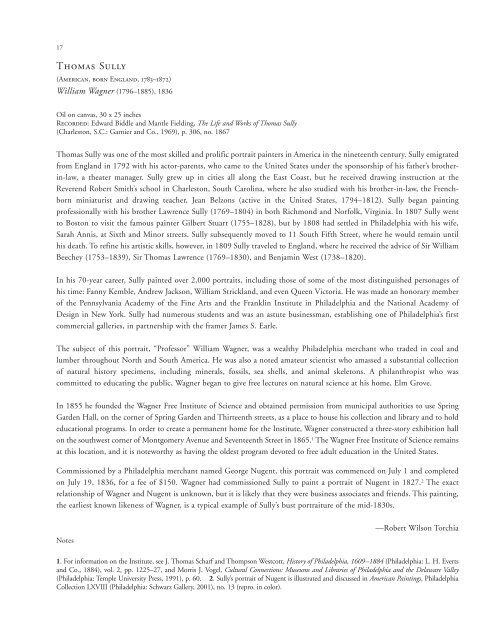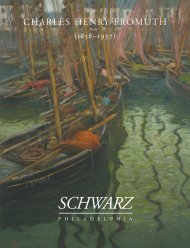pdf - Schwarz Gallery
pdf - Schwarz Gallery
pdf - Schwarz Gallery
You also want an ePaper? Increase the reach of your titles
YUMPU automatically turns print PDFs into web optimized ePapers that Google loves.
17<br />
Thomas Sully<br />
(American, born England, 1783–1872)<br />
William Wagner (1796–1885), 1836<br />
Oil on canvas, 30 x 25 inches<br />
Recorded: Edward Biddle and Mantle Fielding, The Life and Works of Thomas Sully<br />
(Charleston, S.C.: Garnier and Co., 1969), p. 306, no. 1867<br />
Thomas Sully was one of the most skilled and prolific portrait painters in America in the nineteenth century. Sully emigrated<br />
from England in 1792 with his actor-parents, who came to the United States under the sponsorship of his father’s brotherin-law,<br />
a theater manager. Sully grew up in cities all along the East Coast, but he received drawing instruction at the<br />
Reverend Robert Smith’s school in Charleston, South Carolina, where he also studied with his brother-in-law, the Frenchborn<br />
miniaturist and drawing teacher, Jean Belzons (active in the United States, 1794–1812). Sully began painting<br />
professionally with his brother Lawrence Sully (1769–1804) in both Richmond and Norfolk, Virginia. In 1807 Sully went<br />
to Boston to visit the famous painter Gilbert Stuart (1755–1828), but by 1808 had settled in Philadelphia with his wife,<br />
Sarah Annis, at Sixth and Minor streets. Sully subsequently moved to 11 South Fifth Street, where he would remain until<br />
his death. To refine his artistic skills, however, in 1809 Sully traveled to England, where he received the advice of Sir William<br />
Beechey (1753–1839), Sir Thomas Lawrence (1769–1830), and Benjamin West (1738–1820).<br />
In his 70-year career, Sully painted over 2,000 portraits, including those of some of the most distinguished personages of<br />
his time: Fanny Kemble, Andrew Jackson, William Strickland, and even Queen Victoria. He was made an honorary member<br />
of the Pennsylvania Academy of the Fine Arts and the Franklin Institute in Philadelphia and the National Academy of<br />
Design in New York. Sully had numerous students and was an astute businessman, establishing one of Philadelphia’s first<br />
commercial galleries, in partnership with the framer James S. Earle.<br />
The subject of this portrait, “Professor” William Wagner, was a wealthy Philadelphia merchant who traded in coal and<br />
lumber throughout North and South America. He was also a noted amateur scientist who amassed a substantial collection<br />
of natural history specimens, including minerals, fossils, sea shells, and animal skeletons. A philanthropist who was<br />
committed to educating the public, Wagner began to give free lectures on natural science at his home, Elm Grove.<br />
In 1855 he founded the Wagner Free Institute of Science and obtained permission from municipal authorities to use Spring<br />
Garden Hall, on the corner of Spring Garden and Thirteenth streets, as a place to house his collection and library and to hold<br />
educational programs. In order to create a permanent home for the Institute, Wagner constructed a three-story exhibition hall<br />
on the southwest corner of Montgomery Avenue and Seventeenth Street in 1865. 1 The Wagner Free Institute of Science remains<br />
at this location, and it is noteworthy as having the oldest program devoted to free adult education in the United States.<br />
Commissioned by a Philadelphia merchant named George Nugent, this portrait was commenced on July 1 and completed<br />
on July 19, 1836, for a fee of $150. Wagner had commissioned Sully to paint a portrait of Nugent in 1827. 2 The exact<br />
relationship of Wagner and Nugent is unknown, but it is likely that they were business associates and friends. This painting,<br />
the earliest known likeness of Wagner, is a typical example of Sully’s bust portraiture of the mid-1830s.<br />
Notes<br />
—Robert Wilson Torchia<br />
1. For information on the Institute, see J. Thomas Scharf and Thompson Westcott, History of Philadelphia, 1609–1884 (Philadelphia: L. H. Everts<br />
and Co., 1884), vol. 2, pp. 1225–27, and Morris J. Vogel, Cultural Connections: Museums and Libraries of Philadelphia and the Delaware Valley<br />
(Philadelphia: Temple University Press, 1991), p. 60. 2. Sully’s portrait of Nugent is illustrated and discussed in American Paintings, Philadelphia<br />
Collection LXVIII (Philadelphia: <strong>Schwarz</strong> <strong>Gallery</strong>, 2001), no. 13 (repro. in color).



